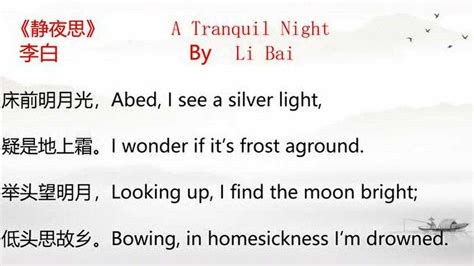Translating classical Chinese poetry into English poetry is a delicate endeavor that requires not only linguistic proficiency but also a deep understanding of both cultures' literary traditions. Each line of classical Chinese poetry is often laden with rich cultural nuances, symbolic imagery, and historical references, making it a challenging yet rewarding task to convey the essence of the original work in a different language. In this guide, we will explore the principles and techniques involved in translating classical Chinese poetry into English, with a focus on maintaining the poetic beauty, preserving the original meaning, and capturing the spirit of the ancient verses.
Before attempting to translate a classical Chinese poem into English, it is crucial to gain a thorough understanding of the original text. This includes studying the historical context, cultural background, and literary devices employed by the ancient poets. Moreover, it's essential to grasp the nuances of the Chinese language, as certain words and phrases may carry multiple meanings or evoke specific cultural connotations.

Classical Chinese poetry often adheres to strict forms and structures, such as the fivecharacter or sevencharacter lines in traditional verse forms like jueju or quatrains. When translating into English, maintaining the original form can be challenging due to differences in syntax, grammar, and phonetics. Translators must strive to preserve the rhythmic patterns, rhyme schemes, and tonal qualities of the original poem while ensuring coherence and naturalness in the target language.
One of the most significant challenges in translating classical Chinese poetry is capturing the vivid imagery and symbolic language used by the ancient poets. Many classical Chinese poems are imbued with natural imagery, seasonal motifs, and metaphysical concepts that may not have direct equivalents in English. Translators must employ creative strategies such as metaphor, simile, and allusion to convey the beauty and depth of the original imagery while adapting it to resonate with Englishspeaking readers.
Translating classical Chinese poetry requires striking a delicate balance between literal accuracy and poetic interpretation. While it is essential to convey the literal meaning of the original text, including its themes, motifs, and narrative elements, translators must also infuse their renditions with poetic sensibility and artistic flair. This may involve reimagining certain phrases, restructuring sentences, or even adding supplementary verses to capture the emotional resonance of the poem in English.
In translating classical Chinese poetry for a modern Englishspeaking audience, it is crucial to remain culturally sensitive and avoid imposing Western perspectives onto the original work. Translators should be mindful of cultural differences in aesthetic preferences, philosophical beliefs, and linguistic conventions, striving to create translations that are faithful to the spirit of the original poem while resonating with contemporary sensibilities. Additionally, providing contextual notes or commentary can enhance readers' appreciation of the cultural nuances embedded in the poetry.
Translating classical Chinese poetry into English poetry is a nuanced and challenging task that requires both linguistic expertise and creative insight. By understanding the original poem's cultural context, preserving its poetic form and imagery, and striking a balance between literal and figurative meaning, translators can create renditions that capture the timeless beauty and profound wisdom of ancient Chinese literature. Through thoughtful adaptation and cultural sensitivity, these translations serve as bridges between different literary traditions, enriching our understanding of human experience across time and space.
文章已关闭评论!
2025-04-05 05:06:27
2025-04-05 04:48:22
2025-04-05 04:30:15
2025-04-05 04:11:55
2025-04-05 03:53:53
2025-04-05 03:35:37
2025-04-05 03:17:25
2025-04-05 02:59:13